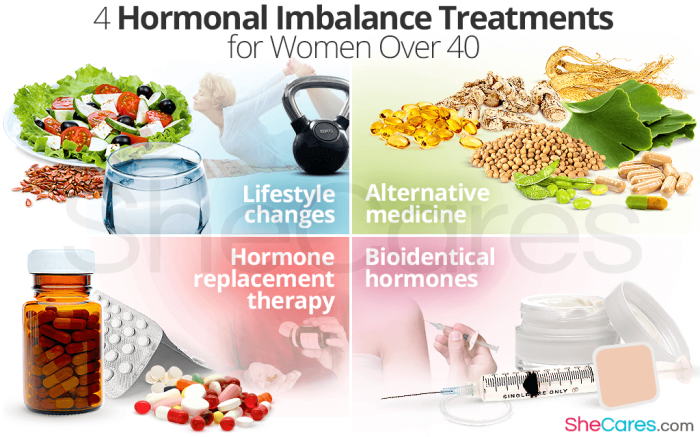
Ever felt like your body’s a rollercoaster? Hormonal imbalances can leave you feeling completely out of whack, from mood swings to unexpected weight changes. But don’t worry, you’re not alone! Millions of women experience hormonal fluctuations, and understanding the root causes—and the available treatments—is the first step towards reclaiming your well-being. This comprehensive guide explores the fascinating world of hormones, revealing how lifestyle, conventional medicine, and alternative therapies can help you find your hormonal harmony.
We’ll delve into the different types of hormonal imbalances, their telltale symptoms, and the various diagnostic tools used to pinpoint the problem. From diet and stress management to hormone replacement therapy and acupuncture, we’ll uncover a wealth of information to empower you to make informed decisions about your health. Get ready to embark on a journey to better understand your body and take control of your hormonal health!
Understanding Hormonal Imbalance

Hormonal imbalances are a common concern for women, affecting various aspects of their physical and mental well-being. These imbalances occur when the body produces too much or too little of certain hormones, disrupting the delicate balance necessary for optimal health. Understanding the different types of imbalances, their symptoms, and diagnostic methods is crucial for effective management and treatment.
Types of Hormonal Imbalances in Women
Several hormonal imbalances can affect women, each with unique characteristics and consequences. These imbalances often stem from various factors, including genetics, lifestyle choices, and underlying medical conditions. Recognizing the specific type of imbalance is key to developing a personalized treatment plan.
Symptoms Associated with Hormonal Imbalances
The symptoms of hormonal imbalances vary widely depending on the specific hormones involved and the individual’s overall health. Many symptoms can overlap, making accurate diagnosis challenging. It’s important to note that experiencing some of these symptoms doesn’t automatically indicate a hormonal imbalance; a proper medical evaluation is necessary for confirmation.
Diagnostic Methods for Hormonal Imbalances
Diagnosing hormonal imbalances involves a combination of methods, tailored to the suspected condition and individual circumstances. These methods aim to accurately assess hormone levels and identify underlying causes.
Comparison of Hormonal Imbalances, Symptoms, and Diagnostic Approaches
| Hormonal Imbalance | Common Symptoms | Diagnostic Approaches |
|---|---|---|
| Polycystic Ovary Syndrome (PCOS) | Irregular periods, acne, excessive hair growth (hirsutism), weight gain, infertility | Pelvic exam, blood tests (hormone levels, glucose), ultrasound |
| Hypothyroidism | Fatigue, weight gain, constipation, dry skin, depression, cold intolerance | Blood tests (thyroid-stimulating hormone, T3, T4) |
| Hyperthyroidism | Weight loss, nervousness, irritability, rapid heartbeat, insomnia, heat intolerance | Blood tests (thyroid-stimulating hormone, T3, T4) |
| Menopause | Hot flashes, night sweats, vaginal dryness, mood swings, sleep disturbances | Blood tests (follicle-stimulating hormone, estradiol), physical exam |
Lifestyle Factors and Hormonal Imbalance
Maintaining hormonal balance is a complex process influenced significantly by our lifestyle choices. What we eat, how we manage stress, and our overall lifestyle habits all play a crucial role in influencing hormone production and function, particularly in women. Understanding these connections empowers us to make proactive changes that can positively impact our hormonal health.
Dietary Influences on Hormonal Balance in Women
Diet plays a pivotal role in regulating hormones. A diet rich in processed foods, refined sugars, and unhealthy fats can disrupt hormonal balance, contributing to issues like irregular periods, weight gain, and acne. Conversely, a balanced diet rich in whole foods can support healthy hormone production. For instance, consuming foods rich in fiber, like fruits and vegetables, helps regulate blood sugar levels, preventing spikes and crashes that can negatively affect hormones.
Similarly, including healthy fats, such as those found in avocados and nuts, provides the building blocks for hormone production.
Stress and Hormonal Fluctuations
Chronic stress significantly impacts hormonal balance. When we experience prolonged stress, our bodies release cortisol, a stress hormone. Elevated cortisol levels can interfere with the production and function of other hormones, including estrogen, progesterone, and testosterone. This disruption can manifest in various ways, from irregular menstrual cycles and increased PMS symptoms to weight gain and difficulty sleeping. The link between stress and hormonal imbalances is undeniable and warrants careful attention.
Stress Management Strategies for Improved Hormonal Health
Effective stress management is paramount for maintaining hormonal balance. Several strategies can help reduce stress levels and their impact on hormones. Regular exercise, even moderate activity like brisk walking, releases endorphins, natural mood boosters that counteract the effects of stress. Mindfulness practices, such as meditation and deep breathing exercises, can help calm the nervous system and reduce cortisol levels.
Prioritizing adequate sleep, aiming for 7-9 hours of quality sleep per night, is crucial as sleep deprivation exacerbates stress and hormonal imbalances. Finally, incorporating relaxation techniques like yoga or spending time in nature can significantly reduce stress and improve overall well-being.
Lifestyle Modifications for Natural Hormone Regulation
Beyond diet and stress management, several lifestyle modifications can support natural hormone regulation. Regular exercise, as mentioned earlier, is beneficial. Maintaining a healthy weight is also crucial, as excess weight can disrupt hormonal balance. Limiting exposure to endocrine-disrupting chemicals found in certain plastics and personal care products can also help. Furthermore, ensuring adequate intake of essential nutrients, particularly vitamins and minerals crucial for hormone production, such as vitamin D and magnesium, is essential.
Finally, prioritizing regular sleep and managing stress are consistently highlighted as key lifestyle elements for hormonal health.
Sample Weekly Meal Plan Promoting Hormonal Balance
A balanced diet is foundational to hormonal health. Here’s a sample weekly meal plan emphasizing whole foods:
- Monday: Breakfast: Oatmeal with berries and nuts; Lunch: Salad with grilled chicken or fish; Dinner: Baked salmon with roasted vegetables.
- Tuesday: Breakfast: Greek yogurt with fruit and chia seeds; Lunch: Leftover salmon and vegetables; Dinner: Lentil soup with whole-grain bread.
- Wednesday: Breakfast: Scrambled eggs with spinach and whole-wheat toast; Lunch: Turkey and avocado sandwich on whole-grain bread; Dinner: Chicken stir-fry with brown rice.
- Thursday: Breakfast: Smoothie with fruits, vegetables, and protein powder; Lunch: Leftover chicken stir-fry; Dinner: Vegetarian chili with cornbread.
- Friday: Breakfast: Whole-wheat pancakes with fruit; Lunch: Salad with chickpeas and feta cheese; Dinner: Pizza with whole-wheat crust, vegetables, and lean protein.
- Saturday: Breakfast: Eggs Benedict with avocado instead of hollandaise; Lunch: Leftover pizza; Dinner: Steak with sweet potato and asparagus.
- Sunday: Breakfast: Waffles with berries and whipped cream; Lunch: Leftover steak and vegetables; Dinner: Roasted chicken with quinoa and green beans.
Remember, this is just a sample plan. Individual needs vary, and consulting a registered dietitian or healthcare professional for personalized dietary advice is recommended.
Conventional Treatment Options
Hormonal imbalances can significantly impact overall health and well-being. Fortunately, a range of conventional medical treatments are available to help restore hormonal balance. These treatments aim to address the underlying cause of the imbalance and alleviate associated symptoms. The choice of treatment depends on several factors, including the specific hormone involved, the severity of the imbalance, and the individual’s overall health.
It’s crucial to consult with a healthcare professional to determine the most appropriate treatment plan.
Hormone Replacement Therapy (HRT)
Hormone replacement therapy (HRT) involves supplementing missing or deficient hormones with synthetic or bioidentical hormones. This treatment is commonly used for conditions like menopause, where estrogen and progesterone levels decline, and hypogonadism, characterized by low testosterone levels. HRT can effectively alleviate symptoms such as hot flashes, night sweats, vaginal dryness, and low libido. However, it’s important to be aware of potential side effects, which can vary depending on the type and dosage of hormones used.
Some potential side effects include increased risk of blood clots, stroke, and certain types of cancer, although the risks are often dependent on individual factors and the specific type of HRT used. The decision to use HRT should be made in consultation with a doctor who can carefully weigh the benefits and risks based on the patient’s individual circumstances and health history.
Selective Estrogen Receptor Modulators (SERMs)
SERMs, such as tamoxifen and raloxifene, are medications that selectively bind to estrogen receptors in different parts of the body. They can mimic the effects of estrogen in some tissues while blocking its effects in others. SERMs are often used to treat conditions like osteoporosis and breast cancer. Benefits include improved bone density and reduced risk of breast cancer recurrence in certain cases.
However, potential side effects can include hot flashes, blood clots, and an increased risk of uterine cancer. Again, careful consideration of individual risk factors is essential before initiating SERM therapy.
Gonadotropin-Releasing Hormone (GnRH) Agonists and Antagonists
GnRH agonists and antagonists are medications that affect the production of gonadotropins, hormones that stimulate the ovaries and testes. GnRH agonists initially stimulate hormone production before suppressing it, while antagonists directly suppress hormone production. These medications are often used in the treatment of certain types of infertility, endometriosis, and prostate cancer. Benefits can include improved fertility outcomes, reduced endometriosis symptoms, and slowed prostate cancer growth.
Side effects may include hot flashes, vaginal dryness, decreased libido, and bone loss.
Other Medical Treatments
Besides the aforementioned treatments, other medical interventions may be used to address specific hormonal imbalances. These could include medications to manage hyperthyroidism or hypothyroidism, insulin therapy for diabetes, or medications to regulate cortisol levels in cases of Cushing’s syndrome or Addison’s disease. The choice of treatment depends entirely on the underlying hormonal disorder and its associated symptoms.
Comparison of Treatment Approaches
| Treatment Option | Benefits | Risks | Suitable For |
|---|---|---|---|
| Hormone Replacement Therapy (HRT) | Alleviates menopausal symptoms, improves bone density | Increased risk of blood clots, stroke, certain cancers | Menopause, hypogonadism |
| Selective Estrogen Receptor Modulators (SERMs) | Improved bone density, reduced risk of breast cancer recurrence (in some cases) | Hot flashes, blood clots, increased risk of uterine cancer | Osteoporosis, breast cancer |
| GnRH Agonists/Antagonists | Improved fertility outcomes, reduced endometriosis symptoms, slowed prostate cancer growth | Hot flashes, vaginal dryness, decreased libido, bone loss | Infertility, endometriosis, prostate cancer |
| Other Medical Treatments (e.g., thyroid medication, insulin) | Addresses underlying hormonal disorder and its symptoms | Varies depending on the specific medication | Various hormonal imbalances (e.g., hypothyroidism, diabetes) |
Alternative and Complementary Therapies

Beyond conventional medicine, a range of alternative and complementary therapies are explored by individuals seeking hormonal balance. These approaches often focus on holistic well-being, addressing the root causes of imbalance rather than solely managing symptoms. While not always backed by the same level of rigorous scientific evidence as conventional treatments, they can offer a valuable adjunct or, in some cases, a primary treatment option for certain individuals.
It’s crucial to remember that these therapies should be discussed with a healthcare professional before implementation, especially if you are already taking other medications.
Acupuncture’s Role in Hormonal Regulation
Acupuncture, a cornerstone of Traditional Chinese Medicine (TCM), involves inserting thin needles into specific points on the body. The underlying principle is that these points stimulate the flow of Qi (vital energy) and blood, thereby restoring balance within the body’s systems, including the endocrine system responsible for hormone production. Studies suggest acupuncture may be beneficial in managing symptoms associated with hormonal imbalances like polycystic ovary syndrome (PCOS) and menopausal symptoms, potentially by influencing hormone levels or reducing stress.
However, the evidence is still considered limited and more large-scale, well-designed studies are needed to confirm its efficacy. While generally safe when administered by a qualified practitioner, potential risks include bruising, infection, and nerve damage, though these are rare.
Herbal Remedies and Their Impact on Hormones
Many herbal remedies are traditionally used to address hormonal imbalances. For example, soy isoflavones, which mimic estrogen, are sometimes used to manage menopausal symptoms. Other herbs, such as chasteberry (vitex), are believed to influence prolactin levels and may be helpful for certain menstrual irregularities. It’s crucial to understand that the efficacy and safety of herbal remedies vary significantly, and the quality and standardization of herbal products can be inconsistent.
Furthermore, interactions with other medications are possible. Therefore, it’s paramount to consult with a healthcare professional or a qualified herbalist before using any herbal remedies, especially if you have pre-existing health conditions or are taking prescription medications. Self-treating can be risky and may delay appropriate medical intervention.
Comparison of Conventional and Alternative Approaches
The choice between conventional and alternative approaches often depends on individual preferences, the severity of the hormonal imbalance, and the response to treatment.
Here’s a comparison:
- Conventional Treatments: Typically involve medication (hormone replacement therapy, birth control pills, etc.), surgery, or other medical interventions. These treatments often offer rapid symptom relief but may have side effects and may not address the underlying causes of the imbalance.
- Alternative Therapies: Often focus on holistic approaches, aiming to address underlying causes and promote overall well-being. They may involve lifestyle changes, acupuncture, herbal remedies, or other complementary therapies. These approaches may take longer to show results and may not be effective for all individuals. The scientific evidence supporting their efficacy is often less robust compared to conventional treatments.
Potential Risks and Limitations of Alternative Treatments
While many alternative therapies are considered safe, it is crucial to be aware of potential risks and limitations. The lack of standardization in herbal remedies can lead to inconsistent product quality and unpredictable effects. Some herbal remedies may interact with prescription medications, leading to adverse reactions. Furthermore, the effectiveness of alternative therapies can vary greatly depending on the individual and the specific condition.
It’s essential to consult with a healthcare professional before using any alternative therapy, particularly if you have pre-existing health conditions or are taking other medications. Misinformation and lack of regulation in the alternative medicine market can also pose risks. For example, some products may contain undisclosed ingredients or harmful substances.
Women’s Health and Hormonal Imbalance
Hormonal imbalances significantly impact women’s lives, affecting everything from their reproductive years to their overall well-being in later life. Understanding these impacts is crucial for proactive health management and improved quality of life. This section will explore the profound connections between hormonal fluctuations and women’s health, focusing on reproductive health, associated conditions, and preventative measures.
Impact of Hormonal Imbalances on Women’s Reproductive Health
Fluctuations in estrogen, progesterone, and other hormones directly influence a woman’s reproductive system. Imbalances can manifest in various ways, including irregular menstrual cycles, heavy bleeding (menorrhagia), painful periods (dysmenorrhea), premenstrual syndrome (PMS), and polycystic ovary syndrome (PCOS). PCOS, for instance, is characterized by hormonal imbalances leading to cystic ovaries, irregular periods, and often infertility. Furthermore, hormonal imbalances can affect fertility, making conception challenging for some women.
Menopause, a natural decline in hormone production, also brings about significant hormonal shifts that can lead to symptoms like hot flashes, night sweats, and vaginal dryness. Early or premature menopause can further complicate reproductive health and overall well-being.
Connection Between Hormonal Imbalances and Other Women’s Health Conditions
The effects of hormonal imbalances extend beyond reproductive health. A strong link exists between estrogen deficiency and osteoporosis, a condition characterized by weakened bones and increased fracture risk. Estrogen plays a vital role in maintaining bone density, and its decline can accelerate bone loss. Similarly, cardiovascular disease risk increases with hormonal imbalances, particularly in postmenopausal women. Changes in lipid profiles and blood pressure regulation, influenced by hormonal fluctuations, contribute to this increased risk.
Additionally, some studies suggest a correlation between hormonal imbalances and conditions like anxiety, depression, and cognitive decline.
Preventative Measures for Maintaining Hormonal Balance
Maintaining hormonal balance is a multifaceted endeavor requiring a holistic approach. A balanced diet rich in fruits, vegetables, and whole grains is crucial. Limiting processed foods, sugar, and unhealthy fats contributes significantly to hormonal stability. Regular exercise, even moderate activity like brisk walking, helps regulate hormone production and improve overall health. Stress management techniques such as yoga, meditation, or spending time in nature are equally important, as chronic stress can disrupt hormonal balance.
Adequate sleep is also essential, as sleep deprivation can negatively affect hormone regulation. Finally, maintaining a healthy weight and avoiding smoking further support hormonal equilibrium.
Visual Representation of the Interconnectedness of Hormones and Women’s Well-being
Imagine a vibrant, interconnected web. At the center is a radiant sun representing a woman’s overall well-being. From this sun, radiating outwards like sunbeams are various colored strands, each representing a different hormone (estrogen, progesterone, testosterone, etc.). These strands intertwine and connect to various aspects of the woman’s health, such as reproductive health (represented by a blossoming flower), bone health (represented by strong, sturdy tree branches), cardiovascular health (represented by a healthy, beating heart), and mental well-being (represented by a calm, peaceful lake).
The strength and vibrancy of each strand and its connection to the central sun reflect the balance of the respective hormone and its impact on overall well-being. If one strand is weak or broken, it impacts the overall health of the web, highlighting the interconnected nature of hormones and their influence on a woman’s holistic well-being. A healthy, balanced web represents a woman experiencing hormonal harmony and optimal health.
Managing Hormonal Imbalance Throughout Life Stages
Hormonal fluctuations are a natural part of life, impacting various bodily functions and overall well-being. Understanding these changes across different life stages is crucial for effective management and maintaining optimal health. This section details the hormonal shifts during puberty, pregnancy, perimenopause, and menopause, highlighting common imbalances and appropriate management strategies.
Puberty and Hormonal Changes
Puberty marks the transition from childhood to adulthood, characterized by significant hormonal shifts initiating sexual maturation. The hypothalamus, pituitary gland, and gonads (ovaries in females and testes in males) interact, leading to increased production of sex hormones like estrogen, progesterone, and testosterone. This surge triggers physical changes such as breast development, menstruation (in females), growth spurts, and the development of secondary sexual characteristics.
Imbalances during puberty can manifest as irregular periods, acne, excessive hair growth (hirsutism), or delayed puberty. Treatment often involves lifestyle modifications like balanced nutrition and regular exercise, along with potential medication to regulate hormone levels if imbalances are significant.
Pregnancy and Hormonal Fluctuations
Pregnancy is marked by dramatic hormonal changes, primarily driven by rising levels of human chorionic gonadotropin (hCG), estrogen, and progesterone. These hormones support fetal development, prepare the body for childbirth, and suppress ovulation. Common hormonal imbalances during pregnancy include gestational diabetes (related to insulin resistance), hyperthyroidism or hypothyroidism (affecting thyroid hormone levels), and pre-eclampsia (characterized by high blood pressure and protein in urine).
Management focuses on monitoring hormone levels, dietary adjustments, medication (if necessary), and regular prenatal check-ups to address any imbalances and ensure a healthy pregnancy.
Perimenopause and Hormonal Shifts
Perimenopause, the transition period leading to menopause, typically begins in a woman’s 40s and is characterized by fluctuating hormone levels, particularly estrogen and progesterone. These fluctuations can cause irregular periods, hot flashes, night sweats, mood swings, sleep disturbances, and vaginal dryness. Hormonal imbalances during perimenopause may include estrogen deficiency or relative estrogen excess (compared to progesterone). Treatment options range from lifestyle changes (diet, exercise, stress management) to hormone replacement therapy (HRT) to alleviate symptoms, depending on individual needs and preferences.
Menopause and Hormonal Changes
Menopause signifies the end of menstruation and reproductive capacity, typically occurring around age 51. Estrogen and progesterone levels decline significantly, leading to various symptoms similar to those experienced during perimenopause, but often more pronounced. Osteoporosis (due to decreased estrogen’s protective effect on bones) is a significant concern. Treatment strategies focus on managing symptoms, preventing osteoporosis (through calcium and vitamin D supplementation, weight-bearing exercise), and addressing other health concerns associated with aging.
HRT remains a viable option for many women, but its use should be carefully considered based on individual risk factors.
Hormonal Imbalance Management Across Life Stages
| Life Stage | Hormonal Changes | Prevalent Imbalances | Management Strategies |
|---|---|---|---|
| Puberty | Increased estrogen, progesterone, testosterone | Irregular periods, acne, hirsutism, delayed puberty | Lifestyle modifications, medication (if needed) |
| Pregnancy | Increased hCG, estrogen, progesterone | Gestational diabetes, hyper/hypothyroidism, pre-eclampsia | Monitoring, dietary adjustments, medication (if needed) |
| Perimenopause | Fluctuating estrogen, progesterone | Estrogen deficiency/excess | Lifestyle changes, HRT (if appropriate) |
| Menopause | Significant decline in estrogen, progesterone | Estrogen deficiency, osteoporosis risk | Symptom management, osteoporosis prevention, HRT (if appropriate) |
Summary
Navigating the world of hormonal imbalances can feel overwhelming, but remember you have options! Whether you choose conventional medical treatments, explore alternative therapies, or focus on lifestyle modifications, taking proactive steps towards hormonal balance is a powerful act of self-care. This guide has equipped you with knowledge and resources to start your journey. Remember to consult with healthcare professionals to create a personalized plan that addresses your unique needs and circumstances.
Embrace this opportunity to prioritize your well-being and rediscover the joy of feeling your best!
Question Bank
What are the long-term effects of untreated hormonal imbalances?
Untreated imbalances can lead to various health problems, including osteoporosis, cardiovascular disease, and infertility. Early intervention is key.
Can hormonal imbalances affect my mental health?
Absolutely! Fluctuations can significantly impact mood, leading to anxiety, depression, and irritability.
Are all hormonal imbalances treated with medication?
No! Lifestyle changes, like diet and stress management, are often effective, especially in conjunction with other treatments.
How often should I get my hormones checked?
This depends on your age, symptoms, and medical history. Consult your doctor for personalized recommendations.





